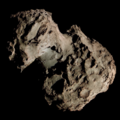169P/NEAT
In this article about 169P/NEAT, we will explore and analyze in detail all the aspects related to this topic that is so relevant today. From its origins to its impact on society, through its different manifestations and evolution over time, we will immerse ourselves in an in-depth study that will allow us to better understand the importance and significance of 169P/NEAT in our daily lives. Through data, research and expert opinions, we will provide a complete overview that will help us reflect on this topic and discover new perspectives that will enrich our knowledge about 169P/NEAT.
| Discovery | |
|---|---|
| Discovered by | NEAT |
| Discovery date | March 15, 2002 |
| Designations | |
| P/2002 EX12 | |
| Orbital characteristics | |
| Epoch | 2022-08-09 (2459800.5) |
| Aphelion | 4.6014 AU |
| Perihelion | 0.60282 AU |
| Semi-major axis | 2.6021 AU |
| Eccentricity | 0.76833 |
| Orbital period | 4.1975 yr |
| Inclination | 11.2985° |
| Last perihelion | 2018 April 29[1] 2014 February 15[2] 2009 November 30 |
| Next perihelion | 2022-Jul-09[1] |
169/NEAT is a periodic comet in the Solar System. It is the parent body of the alpha Capricornids meteor shower in Late July. 169/NEAT may be related to comet P/2003 T12 (SOHO).[3][4] 169P is a low activity comet roughly a few kilometers in diameter.[5] It could have originated from the main asteroid belt.[4]
It last came to perihelion (closest approach to the Sun) on 9 July 2022.[1] On 13 July 2022 passed 0.1395 AU (20.87 million km) from Venus.[6] On 11 August 2026 it will pass 0.1672 AU (25.01 million km) from Earth and then come to perihelion on 21 September 2026.
169P has a similar stable orbit with the smaller body P/2003 T12 (SOHO), both avoiding close encounters with Jupiter. It is possible that both comets likely fragmented from a parent body a bit over 2000 years ago.[4][5] A further fragmentation even about 4,500 to 5,000 years ago could have produced the meteors of the alpha Capricornids meteor shower. The total estimated mass of the meteors is similar to that of the surviving comet.[7]
References
- ^ a b c "169P/NEAT Orbit". Minor Planet Center. Retrieved 2014-06-02.
- ^ Syuichi Nakano (2011-10-29). "169P/NEAT (NK 2135)". OAA Computing and Minor Planet Sections. Retrieved 2012-02-25.
- ^ 169P NEAT and P/2003 T12 - 300 years ago
- ^ a b c Alvarez, Santiago Roland; Oyarzabal, Andrea Sosa (July 2024). "Comet P/2003 T12 (SOHO): A possible fragment of comet 169P/NEAT?". Planetary and Space Science. 246: 105902. doi:10.1016/j.pss.2024.105902.
- ^ a b Sosa, Andrea; Fernández, Julio Angel; Fitzsimmons, Alan (2015). "Comets 169P/NEAT and P/2003 T12 (SOHO): Two possible fragments of a common ancestor?". American Astronomical Society. 29. Bibcode:2015IAUGA..2255583S.
- ^ "JPL Small-Body Database Browser: 169P/NEAT" (last observation: 2022-06-07). Jet Propulsion Laboratory. Retrieved 2022-06-22.
- ^ Jenniskens, P.; Vaubaillon, J. (1 May 2010). "MINOR PLANET 2002 EX 12 (=169P/NEAT) AND THE ALPHA CAPRICORNID SHOWER". The Astronomical Journal. 139 (5): 1822–1830. doi:10.1088/0004-6256/139/5/1822.
External links

